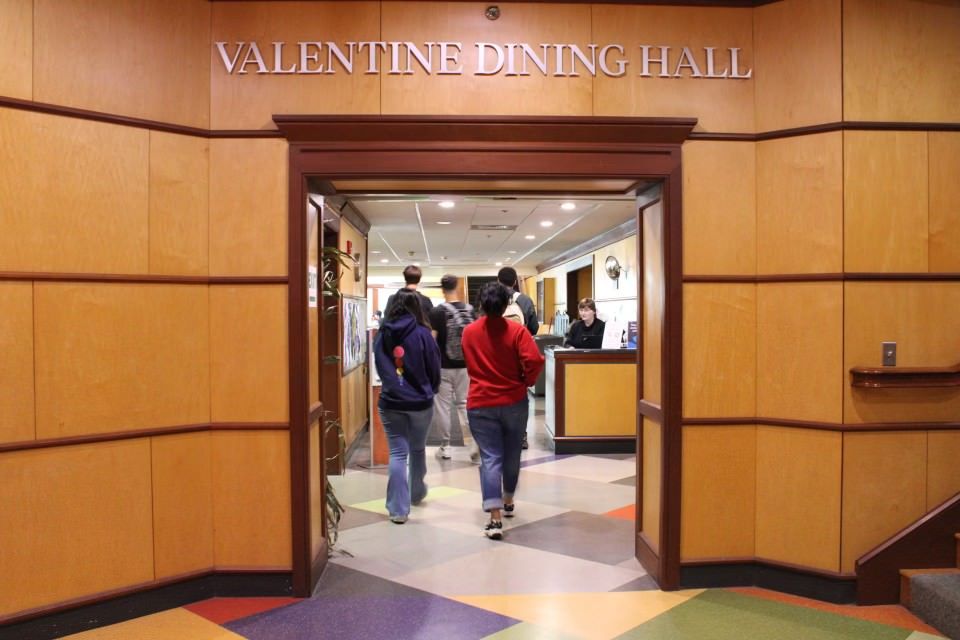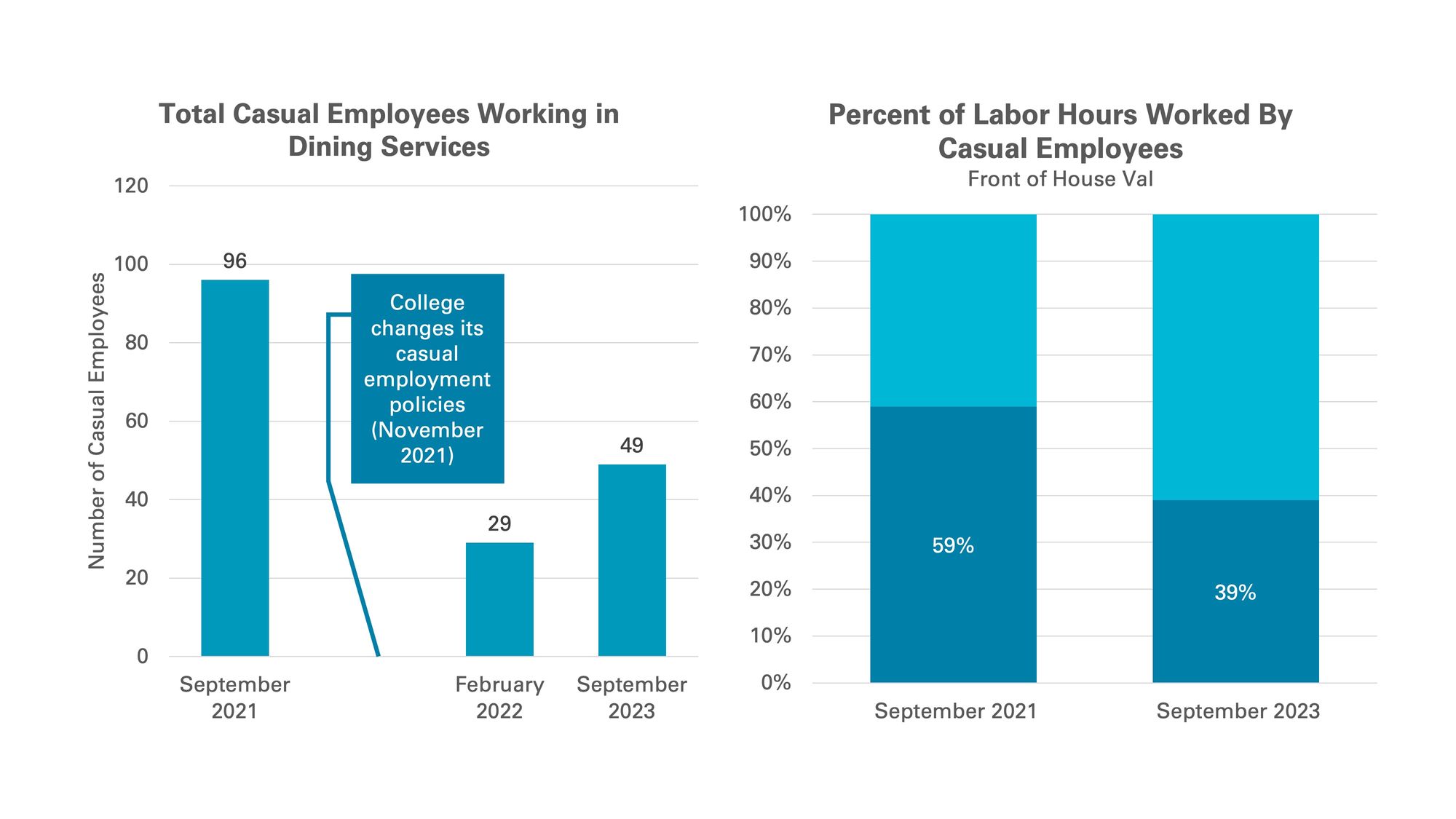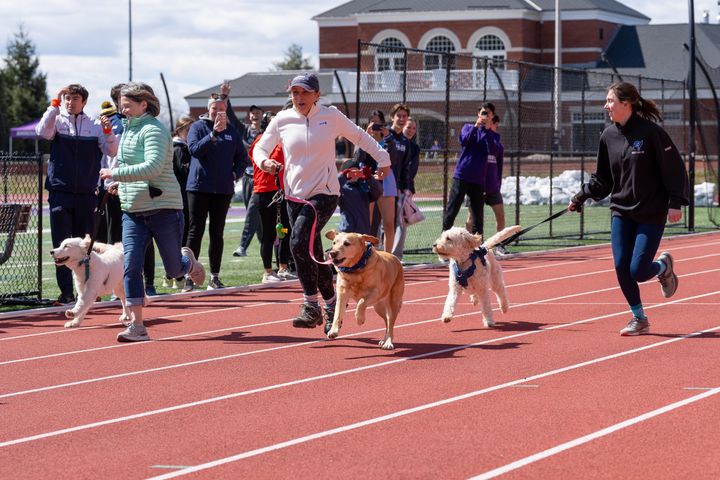Two Years After Policy Change, An Update on Casual Employment
Managing Features Editor emeritus Caelen McQuilkin ’24E spoke with college employees to identify the ongoing challenges posed by Amherst’s “casual employment” system, which limits weekly hours and benefits and accounts for a large portion of Val’s total labor.

Students know Valentine Dining Hall as a space for dining, but it is also a place of work with its own stories relating to labor, pay, and staff experiences. As of this fall, the college employs 143 people in the dining hall. In any given week, operations require more than 2,000 hours of labor.
One important categorization for employees is “casual” versus “regular” employees. Casual employees, hired at a starting wage nearly $3 below that of their counterparts, are intended to be short-term, more flexible employees. In the past few academic years, The Student has covered the college’s use of casual employment, and historically found that it heavily relied on work from lower-paid employees whose roles are often not as temporary or casual as the position description indicates.
Here, The Student checks in on the status of casual employees in dining services this fall semester. Our reporting finds that changes to the casual employment system in November 2021 decreased the number of casual employees and reliance on casual labor at the college. However, the number of casual employees in dining services has begun to increase since the changes were first made, and numbers from the current dining hall schedule show that it still sources a significant chunk of weekly labor from employees working in casual positions.
Defining Casual Employment
As laid out in the college’s Staff Handbook, Amherst categorizes staff who are paid by the hour as either “casual” or “regular” employees.
The college pays casual employees a starting wage close to $3 less than that of regular employees. The Human Resources’ Job Classification and Compensation Program (JCCP), which determines pay scales at the college, does not apply to casual employees. The lowest hourly wage as established by the JCCP is $18.97, and Workday job postings list casual positions at the starting wage of $16.00 per hour. Casual employees also do not qualify for the benefits the college provides, such as healthcare and paid vacation time.
The difference between casual and regular positions is employees’ supposed commitment to working at the college. Casual positions are designed for staff who work part time hours, only expect to work at the college for a short period of time, or wish to work on a more flexible and varied schedule. Local high school students, for example, are one group the administration often cites as potential hires for casual positions.
However, The Student’s reporting from Fall 2021 and this semester shows that the college often bends this policy.
Changes to Casual Labor at the College
In September 2021, The Student reported that despite the Staff Handbook’s definition of casual employees as part-time, short-term employees, the dining hall heavily relied on labor from casual employees who worked regular, full-time hours but received casual-level pay and no benefits.
That November, the college responded to calls for change to this system and converted 23 casual positions to regular, benefitted ones, offering the majority of them to employees who had previously worked casual positions. In an email delivered to faculty on November 2021, then-President Biddy Martin wrote that “going forward, our strategy will be to use benefited staff for the core, day-in-day-out functions of Dining.”
“Over the years … casual positions were created in order to increase grab and go options, expand catering, lengthen hours of operation,” wrote Martin. “It has been clear for some time that these expanded programs are needed for the long haul. It is past time to convert as many positions as possible.”
What is the State of Casual Labor in Dining Services now?
How have these changes held up over time? To look at the dining hall’s current reliance on casual labor, The Student used the weekly employee schedule and information from four employees who chose to remain anonymous in order to retain a comfortable relationship with management.
The Student has found that the college does not source as much labor from casual employees as it did before November 2021. There are fewer total casual positions in dining services, and in these positions, few people work more than twenty hours per week.
However, the dining hall continues to significantly depend on labor from these lower-paid positions. This fall, there are 49 total casual positions in dining services, said former Executive Director of Dining and Hospitality Services Joseph Flueckiger (prior to his Tuesday resignation). This is an increase of 20 casual positions since the college made its conversions.

Front-of-the-house roles — like food servers, ID checkers, and staff who clean tables and dining rooms — is one sector of dining hall operations that is reliant on casual work. The dining hall schedule and information from employees indicates that in one given week this September, 27 front-of-the-house casual employees worked 431 hours out of the 1,100 total, about 39 percent of the total labor required for operations. In comparison, over one week in September 2021, 26 front-of-the-house casual employees’ labor accounted for 59 percent of total hours.
In her November 2021 email, Martin wrote that the college would keep casual positions available “for employees where the work requires a small number of hours or is available for a short and finite period of time or occurs only occasionally, e.g., catering events waitstaff.” Martin specified that casual employment would also be preserved for local high school students and “community partners.”
Current employees said that some of the casual employees do fit this description, including high school students or adults working several jobs. However, some noted that there still are a significant number of employees who don’t fit this criteria, yet work in casual positions which cannot be switched into benefitted ones — the employee has to separately apply for an open benefited position. According to Flueckiger, there are nine open regular positions that employees are encouraged to apply for.
Although there are casual employees who would like to receive some of the benefits afforded to full-time staff members, The Student’s past reporting showed some of the personal and structural barriers that prevent them from applying to the positions.
Testimonies From Casual Employees
Three casual employees who spoke with The Student this fall shared that they would like to be able to work more hours, receive the same wage as their counterparts, and/or receive the same benefits.
One casual employee, Employee A, said that they are unable to work as much as they need to because of the casual position’s hourly constraints. Employee A has been working at the college for three years and repeatedly asks to work more hours each week. However, they’ve been denied the option because they work in a casual position. Since the conversions in Fall 2021, dining administration has gotten stricter about capping the number of hours casual employees can work per week, Employee A said. But for them, cutting hours hasn’t been helpful.
“I’m trying to scrape for 20 [hours per week], but it doesn’t work out,” they said. “It’s a good job to have as a filler when you’re trying to get money … but to make a living, no.”
At the start of Summer 2022, Employee A recounted, supervisors told casual employees that they weren’t needed to work at all. “I couldn’t afford to not work the summer,” they said. “[But] a few weeks went by, and my supervisor was like ‘can you come back and work the summer?’ It didn’t last long … When I got that email from my supervisor, I was, like, ecstatic.”
“[The situation] stressed me out,” they added. “Because that was my only job.”
Another current casual employee, Employee B, noted this issue that has emerged since the November 2021 changes.
“The casuals that are working … they really need those hours,” they said. “I think there are casuals that definitely would work more hours if given the chance.”
Other casual employees expressed their need for some of the other benefits that come with regular positions. “I’m fine with being a casual employee as I have another job and health insurance,” said another current casual employee, Employee C. “But it would be better if I had paid personal and vacation time like others have.”
Reflecting more broadly, Employee A noted that issues like these, as well as “difficulties with some management,” may play into the overall trend of employees leaving the college. In fall 2021, there were a total of 172 staff working in the dining hall. Now, there are 143.
As current employees reflect on the resources they’d like to see given to their time and labor, words from a casual employee interviewed in Fall 2021 remain significant: “What’s the overall value of an equitable workforce to this institution?” they asked. “Are the hundreds of thousands of dollars that are saved through limiting full-time benefited roles on campus worth it, knowing that there is an inequitable division of labor on campus? That’s the question.”





Comments ()